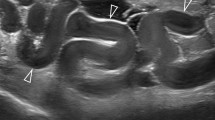Abstract
Background
We wondered whether noncontrast CT performs better than the intravenous urogram (IVU) in the detection of urinary calculi.
Methods
A comprehensive search of the literature was undertaken in order to answer the above question. Both primary and secondary sources of evidence were searched. The retrieved evidence was then appraised.
Results
The strongest evidence was in a meta-analysis by Worster and colleagues (level 1a evidence according to the Oxford/CEBM levels of evidence). This was an analysis of four studies with a total of 296 patients who underwent intravenous urogram and noncontrast CT. This study shows that CT has better diagnostic performance than IVU for the detection of urinary stones.
Conclusions
The literature suggests that CT should be utilized in preference to IVU for patients with suspected urolithiasis.


Similar content being viewed by others
References
Staunton M (2007) Evidence-based radiology: steps 1 and 2—asking answerable questions and searching for evidence. Radiology 242(1):23–31
Haynes RB (2001) Of studies, summaries, synopses, and systems: the “4S” evolution of services for finding current best evidence. Evid Based Ment Health 4(2):37–39
Up to date, http://www.uptodate.com, accessed on February 21, 2007
Worster A, Preyra I, Weaver B, et al. (2002) The accuracy of noncontrast helical computed tomography versus intravenous pyelography in the diagnosis of suspected acute urolithiasis: a meta-analysis. Ann Emerg Med 40(3):280–286
Dalrymple NC, Verga M, Anderson KR, et al. (1998) The value of unenhanced helical computerized tomography in the management of acute flank pain. J Urol 159(3):735–740
Smith RC, Rosenfield AT, Choe KA, et al. (1995) Acute flank pain: comparison of non-contrast-enhanced CT and intravenous urography. Radiology 194(3):789–794
Ha M, MacDonald RD (2004) Impact of CT scan in patients with first episode of suspected nephrolithiasis. J Emerg Med 27(3):225–231
Miller OF, Rineer SK, Reichard SR, et al. (1998) Prospective comparison of unenhanced spiral computed tomography and intravenous urogram in the evaluation of acute flank pain. Urology 52(6):982–987
Niall O, Russell J, MacGregor R, et al. (1999) A comparison of noncontrast computerized tomography with excretory urography in the assessment of acute flank pain. J Urol 161(2):534–537
Sourtzis S, Thibeau JF, Damry N, et al. (1999) Radiologic investigation of renal colic: unenhanced helical CT compared with excretory urography. AJR Am J Roentgenol 172(6):1491–1494
Yilmaz S, Sindel T, Arslan G, et al. (1998) Renal colic: comparison of spiral CT, US and IVU in the detection of ureteral calculi. Eur Radiol 8(2):212–217
PUBMED online search engine. http://www.ncbi.nlm.nih.gov/entrez. Accessed on February 21, 2007
Levels of evidence Oxford Centre for Evidence-Based Medicine Website. http://www.cebm.net/levels_of_evidence.asp. Accessed on May 5, 2007[t1]
http://www.cche.net/usersguides/overview.asp. Accessed on May 5, 2007
Halligan S, Altman DG (2007) Evidence-based practice in radiology: steps 3 and 4—appraise and apply systematic reviews and meta-analyses. Radiology 243(1):13–27
Dodd JD (2007) Evidence-based practice in radiology: steps 3 and 4—appraise and apply diagnostic radiology literature. Radiology 242(2):342–354
Dodd JD, MacEneaney PM, Malone DE (2004) Evidence-based radiology: how to quickly assess the validity, strength of publications in the diagnostic radiology literature. European radiology 14(5):915–922
Mackenzie R, Dixon AK (1995) Measuring the effects of imaging: an evaluative framework. Clin Radiol 50(8):513–518
Acknowledgments
Many thanks to Dr. Dermot Malone, St Vincent’s University Hospital, Dublin 4, Ireland. S. Shine is a fourth year trainee in the program of the Faculty of Radiologists, Royal College of Surgeons in Ireland. EBP methods were learned during the University College Dublin MSc in Radiological Sciences course.
Author information
Authors and Affiliations
Corresponding author
Rights and permissions
About this article
Cite this article
Shine, S. Urinary calculus: IVU vs. CT renal stone? A critically appraised topic. Abdom Imaging 33, 41–43 (2008). https://doi.org/10.1007/s00261-007-9307-0
Published:
Issue Date:
DOI: https://doi.org/10.1007/s00261-007-9307-0




